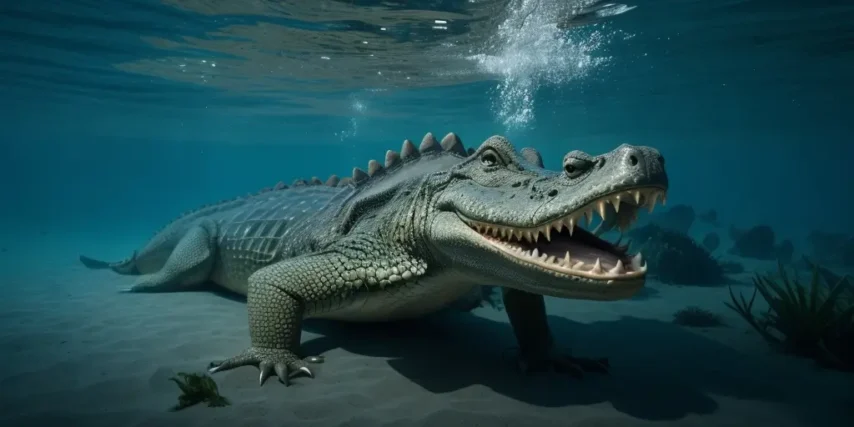Mastering the Art of Deception: The Fascinating World of Crocodile Camouflage
Nature has a way of perfecting the art of survival, and one of its most impressive practitioners is the crocodile. Renowned for their stealth, cunning, and prehistoric demeanor, crocodiles have a remarkable ability to blend seamlessly into their surroundings through the extraordinary phenomenon of camouflage. In this exploration, we’ll delve into the intricate mechanisms behind crocodile camouflage, unraveling the secrets that allow these ancient predators to become masters of deception.
I. The Anatomy of Camouflage:
Camouflage is not merely a passive trait; it’s a sophisticated adaptation that involves both physical and behavioral elements. Crocodiles, equipped with a set of evolutionary tools, have developed a remarkable ability to merge with their environments.

- Skin Coloration:
Crocodiles boast an impressive range of skin colors, from mottled brown and green to gray and black. This diversity is not arbitrary; it serves a crucial purpose in different habitats. For instance, in murky waters, the dark colors help them blend with the shadows, while in green, vegetation-rich environments, the greenish tint provides effective concealment. - Textured Skin:
The texture of a crocodile’s skin plays a pivotal role in its camouflage. Bumpy and scaly, their skin mirrors the textures of the surrounding landscape. This textural mimicry not only helps in breaking up their outlines but also adds an extra layer of concealment by creating an illusion of rocks or debris.
II. Camouflage Strategies:

Beyond their physical attributes, crocodiles employ various strategies to enhance their camouflage, making them virtually invisible to unsuspecting prey and potential threats.
- Ambush Predation:
Crocodiles are renowned for their patient and strategic approach to hunting. By lying in wait just below the water’s surface, with only their eyes and nostrils exposed, they create an illusion of an innocuous log or debris. This motionless state, combined with their natural coloring, turns them into virtually undetectable ambush predators. - Submerged Camouflage:
Crocodiles are equally adept at underwater camouflage. The positioning of their bodies just below the waterline and the slow undulating movements of their tails mimic the flow of water and make them appear as part of the aquatic environment. This submersion technique is a remarkable display of their adaptability to diverse ecosystems.
III. Environmental Influences:
The ability of crocodiles to camouflage is not solely an inherent trait; it is also influenced by the specific environment they inhabit.
- Adaptation to Habitat:
Crocodile species exhibit unique adaptations to their respective habitats. For instance, the Nile crocodile, native to freshwater habitats, tends to have a lighter coloration to blend with the sandy riverbanks, while the saltwater crocodile, inhabiting coastal regions, may have a darker hue to match the mangrove-rich environments. - Temperature Regulation:
Beyond concealment, the coloration of a crocodile’s skin is also linked to temperature regulation. Darker colors absorb more sunlight, helping them warm up quickly in cooler environments. In contrast, lighter colors reflect sunlight, preventing overheating in warmer climates. This dual-purpose feature underscores the intricate balance of adaptation in crocodilian evolution.
IV. The Role of Evolution:
The art of crocodile camouflage is deeply rooted in evolutionary history. Over millions of years, these creatures have honed their camouflage techniques through a process of natural selection.
- Survival of the Fittest:
Crocodiles with superior camouflage abilities were more successful in ambushing prey and evading predators. Consequently, these advantageous traits were passed down through generations, refining the camouflage skills of these ancient predators. - Adaptive Evolution:
The diverse environments crocodiles inhabit have driven the adaptive evolution of their camouflage. From freshwater rivers to brackish swamps and saltwater estuaries, the ability to seamlessly blend into their surroundings has been a key factor in their survival and dominance.

V. Human Fascination and Conservation:
The mastery of crocodile camouflage has captivated human interest for centuries. Beyond its scientific implications, this natural phenomenon has inspired art, folklore, and cultural symbolism. However, as human activities encroach upon natural habitats, the conservation of crocodilian species becomes paramount.
- Conservation Challenges:
Habitat destruction, climate change, and illegal hunting pose significant threats to crocodile populations worldwide. Preservation efforts must be implemented to safeguard the delicate balance between these apex predators and their ecosystems. - Educational Initiatives:
Understanding the intricacies of crocodile camouflage is not only a testament to the wonders of nature but also a call to action for conservation. Educational programs can raise awareness about the importance of preserving these remarkable creatures and the environments they inhabit.
The world of crocodile camouflage is a testament to the marvels of evolution and the intricacies of adaptation. From the coloration of their skin to their patient hunting strategies, crocodiles have perfected the art of disappearing into their surroundings. As we unravel the secrets behind their remarkable camouflage, let it serve as a reminder of the delicate balance that sustains the diversity of life on our planet. It is our responsibility to ensure the continued existence of these awe-inspiring creatures and the ecosystems they call home.







